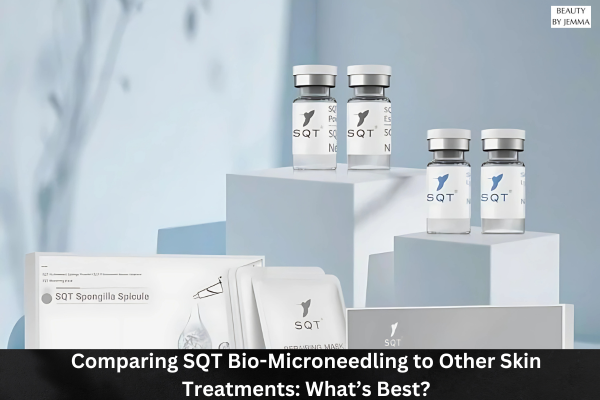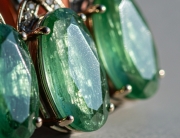When it comes to achieving smooth, youthful skin, there are a variety of treatments available, each offering unique benefits. One of the most talked-about innovations in skincare today is SQT Bio-Microneedling, a treatment that uses biological microneedles to rejuvenate and repair the skin. But how does it compare to other popular skin treatments? Let’s break down how SQT Bio-Microneedling stacks up against other options like traditional microneedling, chemical peels, and laser resurfacing, so you can decide what’s best for your skin.
What is SQT Bio-Microneedling?
Before diving into comparisons, let’s first understand what SQT Bio-Microneedling is. This advanced treatment uses tiny biological needles called spongilla spicules, which are derived from freshwater sponges. These spicules penetrate the skin’s surface to create micro-injuries, triggering the body’s natural healing response. The result? Increased collagen production, skin regeneration, and a brighter, smoother complexion. Unlike traditional microneedling, SQT Bio-Microneedling incorporates bio-stimulation techniques that enhance the skin’s response, leading to quicker and more effective results.
How Does SQT Bio-Microneedling Compare to Traditional Microneedling?
Traditional microneedling has long been a favourite for those looking to boost collagen and improve skin texture. It involves the use of fine, sterile needles to create micro-channels in the skin, encouraging the body to heal itself. Both SQT Bio-Microneedling and traditional microneedling share the goal of collagen stimulation, but there are several key differences between the two.
- Material Used: Traditional microneedling uses metal needles, while SQT Bio-Microneedling uses biocompatible spongilla spicules.
- Bio-Stimulation: SQT Bio-Microneedling incorporates bio-stimulation, enhancing the skin’s response and improving the absorption of active ingredients like serums or growth factors.
- Downtime: Both treatments have minimal downtime, but SQT Bio-Microneedling often leads to faster results due to its bio-stimulation properties.
While both treatments can improve skin texture, reduce scars, and promote collagen production, SQT Bio-Microneedling takes it a step further by enhancing the healing process through bio-stimulation, making it a more effective option for those seeking quicker and more pronounced results.
Comparing SQT Bio-Microneedling to Chemical Peels
Chemical peels are another popular treatment used to exfoliate the skin and promote cell turnover. They involve the application of a chemical solution that removes the top layers of the skin, revealing fresher skin underneath. While both SQT Bio-Microneedling and chemical peels aim to rejuvenate the skin, they do so in different ways.
- Treatment Approach: SQT Bio-Microneedling uses mechanical exfoliation through biological needles, whereas chemical peels rely on acids or ensymes to remove dead skin cells.
- Depth of Treatment: Chemical peels can vary in strength, ranging from superficial to deep peels. SQT Bio-Microneedling works on the skin’s surface and deeper layers but focuses more on stimulating collagen rather than exfoliating.
- Skin Concerns: Chemical peels are excellent for treating surface-level concerns such as pigmentation, sun damage, and fine lines. SQT Bio-Microneedling, on the other hand, works deeper to improve skin structure, making it better suited for addressing scars, fine lines, and overall skin texture.
For those looking for a gentle yet powerful option to improve their skin at both the surface and structural levels, SQT Bio-Microneedling offers a more comprehensive solution compared to chemical peels.
How Does SQT Bio-Microneedling Compare to Laser Resurfacing?
Laser resurfacing is a highly effective treatment for improving skin texture, reducing wrinkles, and addressing pigmentation issues. It uses concentrated light energy to remove layers of skin, promoting collagen production and skin renewal. So how does SQT Bio-Microneedling stack up against laser resurfacing?
- Invasiveness: Laser resurfacing is more invasive than SQT Bio-Microneedling, which means it often requires a longer recovery period and may come with more side effects such as redness or peeling.
- Results: Laser treatments can deliver dramatic results, especially for severe scarring or deep wrinkles. However, they can also be more expensive and involve more discomfort than bio-microneedling.
- Skin Type: Lasers can sometimes cause hyperpigmentation in darker skin tones, making SQT Bio-Microneedling a safer option for all skin types, as it doesn’t use heat or light energy.
For those who want significant skin improvement without the downtime and risks associated with laser treatments, SQT Bio-Microneedling offers a less invasive alternative that still yields impressive results.
Benefits of SQT Bio-Microneedling Over Other Treatments
While every treatment has its advantages, SQT Bio-Microneedling offers several benefits that set it apart from other skincare treatments:
- Minimal Downtime: Unlike laser treatments or deep chemical peels, SQT Bio-Microneedling has minimal recovery time, making it ideal for people with busy lifestyles.
- Natural Ingredients: The use of spongilla spicules makes it a more natural option compared to treatments that rely on chemical solutions or harsh lasers.
- Bio-Stimulation: This feature enhances the skin’s healing process and ensures that active ingredients are absorbed more efficiently, leading to faster, more noticeable results.
- Versatility: SQT Bio-Microneedling is safe for all skin types and can address a wide range of concerns, including wrinkles, scars, and pigmentation.
When to Choose SQT Bio-Microneedling
If you’re looking for a versatile, effective, and minimally invasive treatment that can improve skin texture, reduce the appearance of scars, and enhance collagen production, SQT Bio-Microneedling may be the right choice for you. It’s especially ideal for those seeking a natural approach to skin rejuvenation without the risks associated with more aggressive treatments like lasers or deep chemical peels.
At Beauty By Jemma, we offer SQT Bio-Microneedling as part of our advanced skincare services. This treatment is perfect for individuals looking for a safe, effective way to achieve glowing, youthful skin.
FAQs
- How many SQT Bio-Microneedling sessions will I need?
Most people start seeing results after one session, but for best results, a series of 3-6 treatments spaced about four weeks apart is recommended. - Is SQT Bio-Microneedling suitable for sensitive skin?
Yes, SQT Bio-Microneedling is safe for all skin types, including sensitive skin. The treatment is non-invasive and doesn’t involve harsh chemicals or lasers. - How long does the recovery take?
SQT Bio-Microneedling typically involves minimal downtime. You may experience slight redness and mild sensitivity for a day or two after treatment, but these effects usually subside quickly.
In summary, SQT Bio-Microneedling offers a unique combination of bio-stimulation and natural skin rejuvenation that outperforms traditional microneedling, chemical peels, and laser resurfacing for those seeking a non-invasive yet highly effective skin treatment. Whether you’re looking to improve the texture of your skin, reduce scarring, or simply achieve a more youthful glow, this innovative procedure can help you reach your skincare goals with minimal downtime.






Leave A Comment